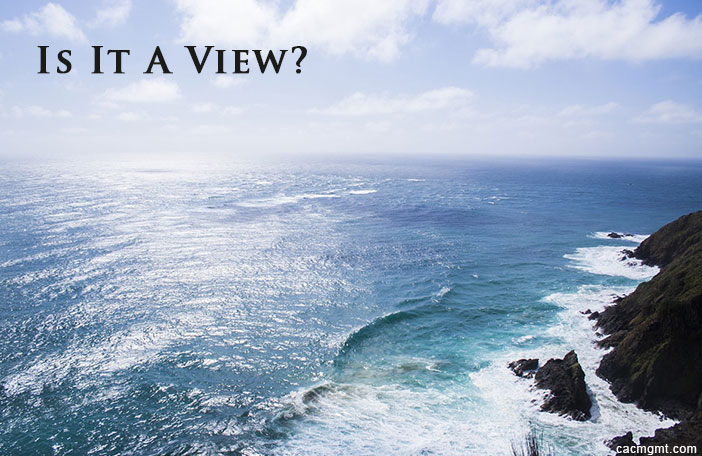Do we really need to protect an ocean view that’s smaller than the size of a hand? Well, below is an article from the Davis-Stirling.com Newsletter by ADAMS | STIRLING PLC regarding “what makes a view”.
What exactly makes it a protected View?
QUESTION: Some owners in our HOA have great views, others none at all. If the ocean is only visible from a corner of the lot and can be covered by one hand at arm’s length, is that a view? We are spending $60,000 per year on idiotic tree trimming.
RESPONSE: I understand the need to keep costs under control. To define a view we have to start with your governing documents.
Typical CC&Rs. View protection language in CC&Rs is never precise. The following two provisions are typical:
…nor shall any tree, shrub or other landscaping be planted or any structures erected that may at present or in the future obstruct the view from any other lot…
No tree, shrub, or other landscaping shall be planted or any structures erected that may unreasonably obstruct the view from any other lot.
What is a “view” and what does “unreasonably obstruct” mean?
Dictionary Definition. Dictionary definitions of “view” are not much help:
Black’s Law Dictionary: “the outlook or prospect from the windows of one’s house.”
Dictionary.com: “View is a general word, referring to whatever lies open to sight: a fine view of the surrounding country. Prospect suggests a sweeping and often distant view, as from a place of vantage: a beautiful prospect to the south.”
Many CC&Rs include language giving the architectural committee or the board authority to determine when an obstruction is unreasonable. Older documents often do not–they provide no definition and no arbiter for determining what is reasonable or unreasonable. That’s where courts come into play.
Case Law. Following are some cases where various view disputes were addressed:
In Seligman v. Tucker (1970), the association’s CC&Rs had a view-protection clause but no standard for determining what view was protected. The court made its own determination that the view being protected was the original view when the houses were built. It decided that a down-slope neighbor who was building a second story on his house unreasonably obstructed plaintiff’s view of the San Fernando Valley. The defendant was ordered to remove his second story.
In Ezer v. Fuchsloch (1979), trees on a neighboring lot had grown such that they almost completely obstructed plaintiff’s view of the ocean. The court interpreted the view language to mean that trees and shrubs had to be trimmed to rooftop height to preserve views. Defendants argued that their 25-foot tall pine tree had an independent right to exist without being trimmed. The court found the “tree rights” argument interesting but unpersuasive. The defendant was ordered to trim all trees and shrubs to rooftop level.
In Zabrucky v. McAdams (2005), the view protection language was unclear as to whether owners could add second stories to their houses. As part of its analysis, the court found that to significantly obstruct any owner’s view of the ocean would depreciate the economic worth of their property as well as dramatically reduce their enjoyment of their home. Since much of the value of properties depended on their views of the ocean, the court broadly interpreted the CC&Rs to prohibit second stories.
In Ekstrom v. Marquesa (2008), the CC&Rs protected views by requiring all trees be trimmed to rooftop level. The board made an exception for palm trees since trimming them would kill them.
When advised by legal counsel that the board’s exception was contrary to the CC&Rs, the board adopted a definition of view that would avoid trimming most palm trees. They defined “view” to be that which is visible from the back of the house, six feet above ground level, standing in the middle of the outside of the house looking straight ahead to infinity, with nothing to the left or right of the lot lines being considered part of the home’s view.
The court rejected the board’s definition. It ruled that the architectural committee had discretion to determine whether any particular palm tree exceeding roof height in fact blocked a view, but the association did not have discretion to exempt trees that blocked views. The association had to trim palm trees even it killed them.
What Is A View? From these cases, it is clear that courts will enforce view protection language in CC&Rs. Unfortunately, they have yet to define a view. If the ocean is only visible from a corner of the lot and can be covered by one hand at arm’s length, is that a view? Probably not. The courts would likely look at those areas of a lot where owner activities primarily occur–from the patio, around the pool, and from the main windows in the house.
RECOMMENDATION. If your CC&Rs state that all vegetation must be trimmed to rooftop height, then you have no choice but to trim all common area trees to that height as often you need to. If your CC&Rs state that view obstructions cannot be unreasonable, then adopt guidelines for determining what obstructions are reasonable and budget accordingly. Getting homeowners to trim their own trees is much more difficult–they tend to be uncooperative when it comes to trimming their own trees. To address this issue, you better add extra legal fees to your budget. – View the actual article
For more knowledgeable information regarding the business of HOA’s, visit: The Davis-Stirling.com Newsletter

